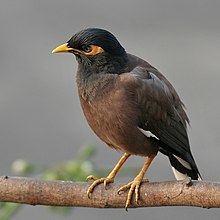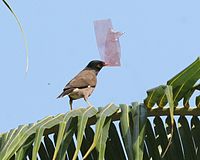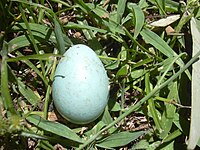Wikipedia:School and university projects/7th Basic Ornithology Course, Pune/Common Myna
IMPORTANT NOTICE: This is the draft of the Wikipedia article on
| Common Myna | |
|---|---|

| |
| In Kolkata, West Bengal, India. | |
| Scientific classification | |
| Domain: | Eukaryota |
| Kingdom: | Animalia |
| Phylum: | Chordata |
| Class: | Aves |
| Order: | Passeriformes |
| Family: | Sturnidae |
| Genus: | Acridotheres |
| Species: | A. tristis
|
| Binomial name | |
| Acridotheres tristis | |
| Subspecies | |
|
Acridotheres tristis melanosternus | |

| |
| Distribution of the Common Myna. Native distribution in blue, introduced in red. | |
The Common Myna or Indian Myna (Acridotheres tristis) also sometimes spelled Mynah, is a member of family
Description
The Common Myna is readily identified by the brown body, black hooded head and the bare yellow patch behind the eye. The bill and legs are bright yellow. There is a white patch on the outer primaries and the wing lining on the underside is white. The sexes are similar and birds are usually seen in pairs.[2]
The Common Myna obeys Gloger's rule in that the birds from northwest India tend to be paler than their darker counterparts in South India.[3][4]
Distribution
It is a species of
The Myna has been introduced in many other parts of the world such as Australia, New Zealand, Hawaii, South Africa, and islands in the Indian Ocean (Seychelles, Mauritius, Maldives, Andaman and Nicobar Islands and Lakshadweep archipelago and also in islands of the Atlantic and Pacific Oceans.[3] The distribution range of Common Myna is on the increase to an extent that in 2000 the
Etymology
The etymology of the scientific name is as follows :[6]
- Acridotheres : Greek akris, akrodos, a locust; theres, a hunter.
- tristis : Latin tristis, sad, gloomy; Modern Latin tristis, dull-coloured).
Type locality
The type locality of the nominate race is Pondicherry, (India).[6]
Taxonomy and subspecies
The Common Myna has two subspecies :[3]
- Acridotheres tristis tristis (Linnaeus, 1758). Widespread, including Sri Lanka.
- A. t. melanosternus Legge, 1879. Endemic to Sri Lanka.
The subspecies melanosternus is darker than the nominate subspecies, has half-black and half-white primary coverts and has a larger yellow cheek-patch.[3][4]
Morphometry
Morphometry is as per Ali & Ripley (2001).[3]
- Body length:23 cms.
| Parameter/sex | Male | Female |
|---|---|---|
| Average weight (gms) | ||
| Wing chord (cms) | ||
| Bill (cms) | ||
| Tarsus (cms) | ||
| Tail (cms) |
Behaviour
Vocalisation


The calls includes croaks, squawks, chirps, clicks and whistles, and the bird often fluffs its feathers and bobs its head in singing. The Common Myna screeches warnings to its mate or other birds in cases of predators in proximity or when its about to take off flying.[7] Common Mynas are popular as cage birds for their singing and "speaking" abilities. Before sleeping in communal roosts, mynas vocalise in unison which is called as "communal noise".[8]
Breeding
Common Mynas are believed to pair for life. They breed through much of the year depending on the location, building their nest in a hole in a tree or wall. They breed from sea-level to 3000 m in the Himalayas.[3]
The normal clutch size is 4–6 eggs. The average size of the egg is 30.8 x 21.99 mm. The incuation period is 17 to 18 days and fledging period is 22 to 24 days.
During the breeding season, the daytime activity-time budget of Common Myna in Pune in April to June 1978 has been recorded to comprise the following: nesting activity (42%), scanning the environment (28%), locomotion (12%), feeding (4%), vocalisation (7%) and preening-related activities, interactions and other activities (7%).[10]
The Common Myna uses the nests of woodpeckers, parakeets, etc. and easily takes to nest boxes; it has been recorded evicting the chicks of previously nesting pairs by holding them in the beak and later sometimes not even using the emptied nest boxes. This aggressive behaviour is considered to contribute to its success as an invasive species.[11]
Food and feeding
Like most starlings, the Common Myna is omnivorous. It feeds on insects, arachnids, crustaceans, reptiles, small mammals, seeds, grain and fruits and discarded waste from human habitation. It forages on the ground among grass for insects, and especially for
Roosting behaviour

Common Mynas roost communally throughout the year, either in pure or mixed flocks with
The function of communal roosting is to synchronise various social activities, avoid predators, exchange information about food sources.[17]
Communal displays (pre-roosting and post-roosting) comprise of aerial maneuvers which are exhibited in the pre-breeding season (November to March). It is assumed that this behaviour is related to pair formation.[18]
Habitat
This abundant passerine is typically found in open woodland, cultivation and around habitation.
Although this is an adaptable species, its population has been decreasing significantly in Singapore and Malaysia (locally called as 'gembala kerbau', literally 'buffalo shepherd') due to competition with its cousin, the introduced
Urban success

The Common Myna thrives in urban and suburban environments; in Canberra, for instance, 110 Common Mynas were released between 1968 and 1971. By 1991, Common Myna population density in Canberra averaged 15 birds per square kilometer.[20] Only three years later, a second study found an average population density of 75 birds per square kilometer in the same area.[21]
The bird likely owes its success in the urban and suburban settings of Sydney and Canberra to its evolutionary origins; having evolved in the open woodlands of India, the Common Myna is pre-adapted to habitats with tall vertical structures and little to no vegetative ground cover,[22] features characteristic of city streets and urban nature preserves.
The Common Myna (along with
Invasive species
The IUCN declared this myna as one of the only three birds among the
The Common Myna is a pest in South Africa, North America, the Middle East, Australia, New Zealand and many Pacific islands. It is particularly problematic in Australia. Several methods have been tried to control the bird's numbers and protect native species.
Australia

In
The Common Myna was first introduced to Australia in
The bird can live and breed in a wide range of temperatures, though it thrives in hotter regions. Self-sustaining populations of Common Myna have been found in regions of mean warmest month temperature no less than 23.2°C and mean coldest month temperature no less than -0.4°C, implying that the Common Myna could potentially spread from Sydney northward along the eastern coast to Cairns and westward along the southern coast to Adelaide (though not toTasmania, Darwin, or across the Great Dividing Range to the arid interior regions).[29]
South Africa
In South Africa where it escaped into the wild in 1902, it has become very common and its distribution is greater where human populations are greater or where there is more human disturbance.[30] The bird is also notorious for being a pest, kicking other birds out of their nests and killing their young due to the Myna's strong territorial instinct, in South Africa it is considered somewhat of a major pest and disturbance of the natural habitat, so they are frequently shot and killed by people in urban environments and farmers alike.[citation needed]
Effect on ecosystems and humans
Threat to native birds

The Common Myna is a hollow-nesting species; that is, it nests and breeds in protected hollows found either naturally in trees or artificially on buildings (for example, recessed windowsills or low eaves).[31] Compared to native hollow-nesting species, the Common Myna is extremely aggressive, and breeding males will actively defend areas ranging up to 0.83 hectares in size (though males in densely populated urban settings tend to only defend the area immediately surrounding their nests).[32]
This aggressiveness has enabled the Common Myna to displace many breeding pairs of native hollow-nesters, thereby reducing their reproductive success. In particular, the reproduction rates of native hollow-nesting parrots in the
The Common Myna is also known to maintain up to two roosts simultaneously; a temporary summer roost close to a breeding site (where the entire local male community sleeps during the summer, the period of highest aggression), and a permanent all-year roost where the female broods and incubates overnight. Both male and female Common Mynas will fiercely protect both roosts at all times, leading to further exclusion of native birds.[32]
Threat to crops and pasture

The Common Myna (which feeds mostly on ground-dwelling insects, tropical fruits such as grapes plums and someberries and, in urban areas, discarded human food)[33] poses a serious threat to Australian blueberry crops, though its main threat is to native bird species.[34]
In Hawaii, where the Common Myna was introduced to control pest armyworms and cutworms in sugarcane crops, the bird has helped to spread the robust Lantana camara weed across the islands’ opengrasslands.[35]
In culture
The Common Myna widely appears under the name saarika in Indian culture from Vedic times, featuring both in classical Indian literature (Sanskrit) as well as in
In Sanskrit literature, the Common Myna has a number of names, most are descriptive of the appearance or behaviour of the bird. In addition to saarika, the names for the Common Myna include kalahapriya, which means "one who is fond of arguments" referring to the quarrelsome nature of this bird; chitranetra, meaning "picturesque eyes"; peetanetra (one with yellow eyes) and peetapaad (one with yellow legs).[37]
References
- ^ a b Lowe S.; Browne M.; Boudjelas S.; de Poorter M. (2000). 100 of the World’s Worst Invasive Alien Species. A selection from the Global Invasive Species Database. The Invasive Species Specialist Group (ISSG), a specialist group of the Species Survival Commission (SSC) of the World Conservation Union (IUCN), Auckland.
- ^ Rasmussen, PC & JC Anderton (2005). Birds of South Asia: The Ripley Guide. Vol 2. Smithsonian Institution & Lynx Edicions. p. 584.
- ^ ISBN 0195659384.
- ^ ISBN 8487334660.
- ^ a b "Common Myna". Retrieved December 23, 2007.
- ^ ISBN 9780198066255.
- .
- ^ a b Mahabal, Anil; Vaidya, V.G. (1989). "Diurnal rhythms and seasonal changs in the roosting behaviour of Indian Myna 'Acridotheres tristis (Linnaeus)". Proceedings of Indian Academy of Sciences (Animal Science). 98 (3). Indian Academy of Sciences, Bangalore: 199–209.
- ^ Choudhury A. (1998). "Common Myna feeding a fledgling koel". Journal of the Bombay Natural History Society. 95 (1): 115.
- ^ Mahabal, Anil (1991). "Activity-time budget of Indian Myna Acridotheres tristis (Linnaeus) during the breeding season". Journal of the Bombay Natural History Society. 90 (1). Bombay Natural History Society: 96–97.
- ISBN 0195668782.
- ^ Mathew, DN; Narendran, TC; Zacharias, VJ (1978). "A comparative study of the feeding habits of certain species of Indian birds affecting agriculture". J. Bombay Nat. Hist. Soc. 75 (4): 1178–1197.
- ^ Mahabal, Anil; Bastawade, D.B. (1991). "Mixed roosting associates of Indian Myna Acridotheres tristis in Pune city, India". Pavo. 29 (1 & 2). Department of Zoolgy, Maharaja Sayajirao Gaikwad University, Vadodara: 23–32.
- ^ Mahabal, Anil (1992). "Diurnal intra- and inter-specific assemblages of Indian Mynas". Biovigyanam. 18 (2). Maharashtra Association for the Cultivation of Science, Pune: 116–118.
- ^ Mahabal, Anil; Bastawade, D.B.; Vaidya, V.G. (1990). "Spatial and temporal fluctuations in the population of Common Myna Acridotheres tristis (Linnaeus) in and around an Indian City". Journal of the Bombay Natural History Society. 87 (3). Bombay Natural History Society, Mumbai: 392–398.
- ^ Mahabal, Anil (1993). "Seasonal changes in the flocking behaviour of Indian Myna 'Acridotheres tristis (Linnaeus)". Biovigyanam. 19 (1 & 2). Maharashtra Association for the Cultivation of Science, Pune: 55–64.
- ^ Mahabal, Anil (1997). "Communal roosting in Common Mynas and its functional significanca". Journal of the Bombay Natural History Society. 94 (2). Bombay Natural History Society, Mumbai: 342–349.
- ^ Mahabal, Anil (1993). "Communal display behaviour of Indian Myna 'Acridotheres tristis(Linnaeus)". Pavo. 31 (1&2). Department of Zoolgy, Maharaja Sayajirao Gaikwad University, Vadodara: 45–54.
- ^ Bird Ecology Study Group, Nature Society (Singapore):<http://besgroup.blogspot.com/2005/12/ubiquitous-javan-myna.html>. Accessed 25 Oct 2007
- doi:10.1071/MU97018.
- ^ Pell 1997, p.146
- ^ Pell 1997, p.141
- doi:10.1071/MU01028.
- ^ Lowe S., Browne M., Boudjelas S. and de Poorter M. (2000). 100 of the World’s Worst Invasive Alien Species. A selection from the Global Invasive Species Database. The Invasive Species Specialist Group (ISSG), a specialist group of the Species Survival Commission (SSC) of the World Conservation Union (IUCN), Auckland.
- ^ Wilme, Lucienne (1996). "Composition and characteristics of bird communities in Madagascar" (PDF). Biogéographie de Madagascar: 349–362.
- ^ ABC Wildwatch
- ^ .
- .
- ^ Martin 1996, pp.169–170
- ^ Derick S. Peacock, Berndt J. van Rensburg and Mark P. Robertson (2007). "The distribution and spread of the invasive alien Common Myna, Acridotheres tristis L. (Aves: Sturnidae), in southern Africa". South African Journal of Science. 103: 465–473.
- ^ a b Bomford 2002, p.34
- ^ a b Pell 1997, p.148
- ^ Pell 1997, p.147
- ^ Bomford 2002, p.30
- .
- ^ Pande, Dr Suruchi. (2007). Some reflections on birds in Sanskrit literature. (A Thesis submitted for the degree of Vidyavachaspati (PhD) (Sanskrit) awarded from Shri Balmukund Lohiya Centre of Sanskrit and Indological Studies, Tilak Maharashtra Vidyapeeth, Pune).
- ISBN 8120818423.
Further reading
- Feare, Chris; Craig, Adrian (1999). Starlings and Mynas. Princeton University Press. ISBN 0-7136-3961-X.
- Grimmett, Inskipp and Inskipp, Birds of India ISBN 0-691-04910-6
- Pell, A.S. & Tidemann, C.R. (1997) "The impact of two exotic hollow-nesting birds on two native parrots in savannah and woodland in eastern Australia", Biological Conservation, 79, 145-153. A study showing native birds being excluded from up to 80% of nesting sites in Canberra, Australia.
External links
- ANU Indian Common Myna page Explains why Mynas are a problem and what can be done to control them.
- Common Myna videos, photos & sounds on the Internet Bird Collection
- Indian Myna Control Handbook
- "Acridotheres tristis". Integrated Taxonomic Information System. Retrieved 23 February 2009.
- Common Myna video on Wild Sri Lanka

